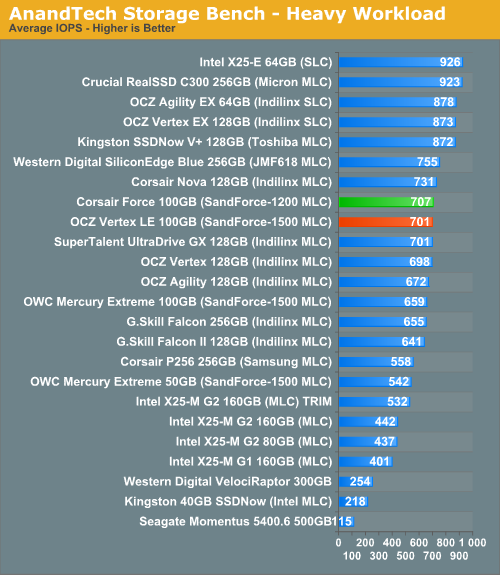Corsair's Force SSD Reviewed: SF-1200 is Very Good
by Anand Lal Shimpi on April 14, 2010 2:27 AM ESTAnandTech Storage Bench
Note that our 6Gbps controller driver isn't supported by our custom storage bench here, so the C300 results are only offered in 3Gbps mode.
The first in our benchmark suite is a light usage case. The Windows 7 system is loaded with Firefox, Office 2007 and Adobe Reader among other applications. With Firefox we browse web pages like Facebook, AnandTech, Digg and other sites. Outlook is also running and we use it to check emails, create and send a message with a PDF attachment. Adobe Reader is used to view some PDFs. Excel 2007 is used to create a spreadsheet, graphs and save the document. The same goes for Word 2007. We open and step through a presentation in PowerPoint 2007 received as an email attachment before saving it to the desktop. Finally we watch a bit of a Firefly episode in Windows Media Player 11.
There’s some level of multitasking going on here but it’s not unreasonable by any means. Generally the application tasks proceed linearly, with the exception of things like web browsing which may happen in between one of the other tasks.
The recording is played back on all of our drives here today. Remember that we’re isolating disk performance, all we’re doing is playing back every single disk access that happened in that ~5 minute period of usage. The light workload is composed of 37,501 reads and 20,268 writes. Over 30% of the IOs are 4KB, 11% are 16KB, 22% are 32KB and approximately 13% are 64KB in size. Less than 30% of the operations are absolutely sequential in nature. Average queue depth is 6.09 IOs.
The performance results are reported in average I/O Operations per Second (IOPS):

I've always loved the performance of SandForce's controllers, I've just been worried about their reliability. While we wait for the latter to prove itself over time, the performance is very good today. The Corsair Force is very competitive, as fast as any other SF drive and faster than nearly all other SSDs.
If there’s a light usage case there’s bound to be a heavy one. In this test we have Microsoft Security Essentials running in the background with real time virus scanning enabled. We also perform a quick scan in the middle of the test. Firefox, Outlook, Excel, Word and Powerpoint are all used the same as they were in the light test. We add Photoshop CS4 to the mix, opening a bunch of 12MP images, editing them, then saving them as highly compressed JPGs for web publishing. Windows 7’s picture viewer is used to view a bunch of pictures on the hard drive. We use 7-zip to create and extract .7z archives. Downloading is also prominently featured in our heavy test; we download large files from the Internet during portions of the benchmark, as well as use uTorrent to grab a couple of torrents. Some of the applications in use are installed during the benchmark, Windows updates are also installed. Towards the end of the test we launch World of Warcraft, play for a few minutes, then delete the folder. This test also takes into account all of the disk accesses that happen while the OS is booting.
The benchmark is 22 minutes long and it consists of 128,895 read operations and 72,411 write operations. Roughly 44% of all IOs were sequential. Approximately 30% of all accesses were 4KB in size, 12% were 16KB in size, 14% were 32KB and 20% were 64KB. Average queue depth was 3.59.

Once again, very little difference between Corsair's Force and OCZ's Vertex LE. SandForce's performance isn't as strong in our heavy downloading workload, the Corsair Nova (with the latest Indilinx firmware) actually does better.
The gaming workload is made up of 75,206 read operations and only 4,592 write operations. Only 20% of the accesses are 4KB in size, nearly 40% are 64KB and 20% are 32KB. A whopping 69% of the IOs are sequential, meaning this is predominantly a sequential read benchmark. The average queue depth is 7.76 IOs.

Here we're completely bound by read performance. I'm afraid the only way you'll get faster is via RAID or a 6Gbps controller in Crucial's case.










63 Comments
View All Comments
marc_soad - Thursday, April 15, 2010 - link
If I'm not wrong, what the author means is 2 000 000 hours = 83 333 days = 228 years.So the drive is meant to fail after 228 years if it's powered on all the time, or more if the computer is powered on only for a portion of the day.
Thanks for the review by the way! :)
p05esto - Friday, April 16, 2010 - link
Hey, I COMPLETELY agree with the printing thing....I hate articles that have "pages", I'd rather view a 10 page long single document....yes, I'm that frickin lazy. You shouldn't remove the pages, but offer a FULL view option? I use the print option sometimes as well just to read an article all at once.poee - Friday, July 16, 2010 - link
"Performance is down, as you'd expect, but not to unbearable levels and it's also pretty consistent."Why is performance down? Why should we "expect" this? Do I have to read every SSD article you've written previously to understand new articles? Or is there one big article that has all the info that you obliquely allude to in subsequent articles?
Where can I find the current recommendations for SSDs (SandForce vs Indilinx vs Intel vs Micron vs Samsung, latest firmware updates, etc.)? Is there a central repository of SSD information that is assimilated and arranged categorically (for easy research), or must all this info be followed like a blog?